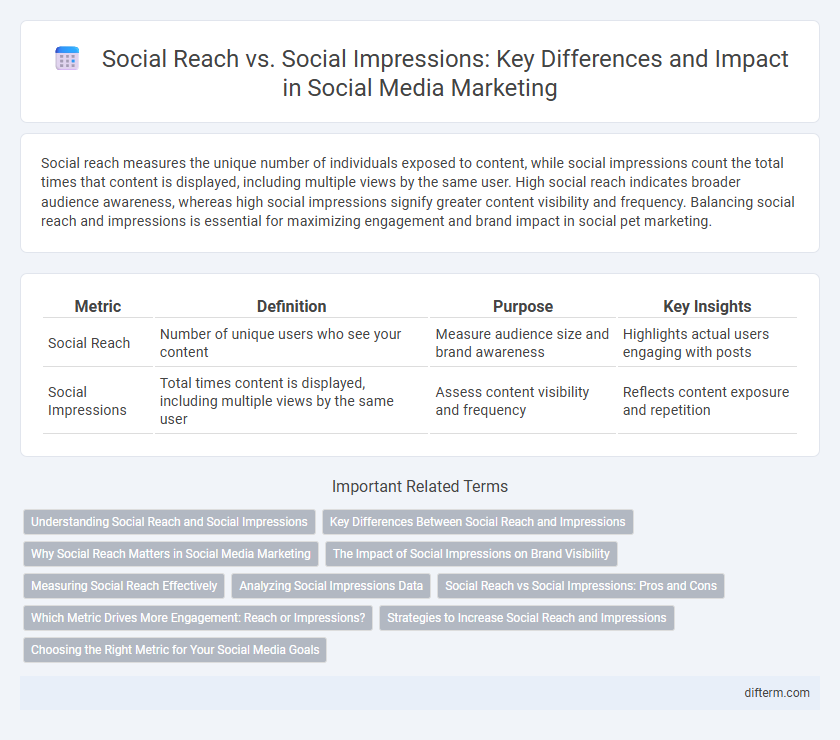Social reach measures the unique number of individuals exposed to content, while social impressions count the total times that content is displayed, including multiple views by the same user. High social reach indicates broader audience awareness, whereas high social impressions signify greater content visibility and frequency. Balancing social reach and impressions is essential for maximizing engagement and brand impact in social pet marketing.
Table of Comparison
| Metric | Definition | Purpose | Key Insights |
|---|---|---|---|
| Social Reach | Number of unique users who see your content | Measure audience size and brand awareness | Highlights actual users engaging with posts |
| Social Impressions | Total times content is displayed, including multiple views by the same user | Assess content visibility and frequency | Reflects content exposure and repetition |
Understanding Social Reach and Social Impressions
Social reach measures the number of unique users who have seen your content, while social impressions count the total number of times that content is displayed, including multiple views by the same user. Understanding the difference between these metrics is crucial for evaluating the effectiveness and visibility of social media campaigns. Higher reach indicates broader audience exposure, whereas impressions reflect overall content frequency and engagement potential.
Key Differences Between Social Reach and Impressions
Social reach measures the total number of unique users who see your content, while social impressions count the total number of times the content is displayed, including multiple views by the same user. Reach indicates audience size and potential new exposure, whereas impressions reflect content frequency and visibility across platforms. Understanding these key differences helps optimize social media strategies by balancing audience expansion and content repetition.
Why Social Reach Matters in Social Media Marketing
Social reach measures the unique number of users exposed to content, making it a critical metric for evaluating audience size and potential brand influence. Unlike social impressions, which count total views including multiple exposures to the same user, reach helps marketers understand the breadth of their message's penetration. Emphasizing social reach enables targeted campaigns to maximize brand awareness and engagement with distinct audiences.
The Impact of Social Impressions on Brand Visibility
Social impressions measure how often content is viewed, significantly amplifying brand visibility by increasing exposure across diverse audiences. High social impressions enhance brand recognition and reinforce messaging, contributing to greater overall engagement and potential customer conversion. Unlike social reach, which counts unique users, social impressions reflect total content views, providing deeper insight into the frequency and impact of brand interactions.
Measuring Social Reach Effectively
Measuring social reach effectively involves tracking the unique users who have seen your content, providing a clear picture of your audience size and potential influence on social platforms like Facebook, Instagram, and Twitter. Social impressions measure the total number of times your content is displayed, including multiple views by the same user, which can inflate perceived engagement without indicating actual audience breadth. Focusing on reach metrics helps marketers understand actual audience penetration and tailor strategies to increase genuine visibility and engagement.
Analyzing Social Impressions Data
Analyzing social impressions data reveals how often content is displayed, providing insight into brand visibility across platforms. Social impressions quantify exposure opportunities, whereas social reach measures the unique users who see the content, highlighting audience breadth. Understanding the disparity between impressions and reach is crucial for optimizing content strategy and enhancing engagement metrics.
Social Reach vs Social Impressions: Pros and Cons
Social reach measures the unique users who see your content, offering a clear view of audience size and potential engagement, while social impressions count total views including multiple exposures by the same user, highlighting overall content visibility. Higher reach indicates a broad audience base essential for brand awareness, whereas increased impressions suggest strong content frequency and reinforcement. Focusing solely on reach might overlook repeated engagements that deepen brand impact, whereas concentrating only on impressions can inflate success metrics by counting repeated views without unique audience growth.
Which Metric Drives More Engagement: Reach or Impressions?
Social reach measures the unique number of users who see your content, while social impressions count the total times the content is displayed, including multiple views by the same user. Reach typically drives higher engagement rates because it exposes your message to a broader and more diverse audience, increasing the potential for likes, comments, and shares. In contrast, impressions can inflate visibility metrics but may include repeated exposures that contribute less to active user interaction.
Strategies to Increase Social Reach and Impressions
Maximizing social reach and impressions requires a strategic approach that includes optimizing content timing based on audience activity patterns and leveraging targeted hashtags to expand visibility. Engaging with followers through interactive posts and collaborations with influencers can amplify content distribution, thereby increasing both reach and impressions effectively. Consistent analysis of platform insights enables fine-tuning of campaigns to prioritize high-performing content types and posting schedules.
Choosing the Right Metric for Your Social Media Goals
Social reach measures the total number of unique users who see your content, while social impressions count the total times your content is displayed, regardless of repeated views by the same users. Choosing the right metric depends on your social media goals: prioritize social reach to evaluate brand awareness and audience size, or focus on social impressions to assess content visibility and engagement frequency. Aligning your metrics with objectives enhances campaign effectiveness and provides clearer insights into audience interaction.
social reach vs social impressions Infographic

 difterm.com
difterm.com